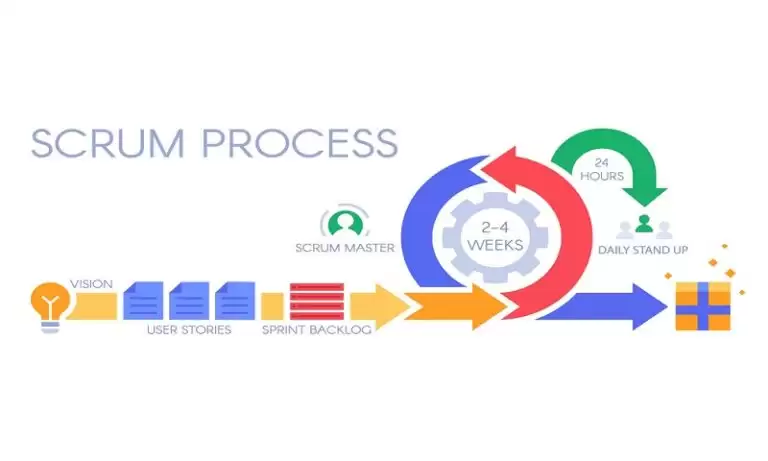Scrum was voted as the most popular Agile framework (66%) as per the 15thState of Agile Report.
Before we learn ‘What is Scrum?’It’s important to understand the origin of scrum.
The term Scrum in software development traces its origin back to 1986 when Hirotaka Takeuchi and Ikujiro Nonaka first used it in their paper titled “The New New Product Development Game”.
It was published in the January issue of 1986 of the Harvard Business Review. As a trivia, Scrum is a term used in Rugby meaning formation of players.
Let’s move on to the definition of Scrum.
What is Scrum?
Scrum is an agile framework for managing complex projects such as software development. It is based on iterations and the development happens in increments.
It is a lightweight framework that helps people, teams, and organizations produce value through adaptive solutions for complicated problems.
Scrum Roles
Scrum has 3 roles that are essential for planning, organizing, and optimizing the process. All of them are central to its success.
Product Owner
According to the Scrum Guide, theProduct Owner is responsiblefor maximizing the value of the product resulting from the work of the Scrum Team.
That’s not all. The Product Owner has additional responsibilities such as-
- Developing and communicating the Product Goal clearly
- Creating and communicating Product Backlog items
- Ordering Product Backlog item
- Make sure that the product backlog is visible and comprehended
Scrum Master
The Scrum Master is accountable for ensuring the team follows all the agile principles and values. They also see to it that they follow all the processes and practices.
The responsibilities of Scrum Master are as follows-
- Overcoming hurdles
- Ensuring that the team has an environment conducive for optimum performance
- Build team dynamics
- Set the seal on creating harmony between the team and product owner as well as the external members
- Shielding the team from external interruptions and distractions
Development Team
The Development team consists of Scrum Developers. As per the Scrum guide, scrum developers are members dedicated to the creation of anyfeatureof a usable increment each sprint.
The responsibilities of Scrum Developers are listed below-
- Drafting a plan for Sprints and Sprint Backlog
- Infusing quality by following the definition of Done
- Adapting their plan each day towards the Sprint goal
- Maintain accountability towards each other as professionals
Scrum Process
The Sprint workflow is designed to help the team members assess their work and communicate with each other during the development process. The workflow is constant in every sprint. The process includes the following-
● Sprint Planning
The team assesses the user stories and decides the list of features to be prioritized in the upcoming sprint.
● Sprint
The time frame in which the work must be completed within the time period. It is usually 1 to 4 weeks.
● Daily Scrum
Daily Scrum is a standup meeting held by the Scrum Master, where the team discusses the progress, the things that are currently in progress and issues that the team is facing.
● Final Deliverable
The final deliverable is the working product. The Product Owner decides if the product is ready for release or additional features are needed.
● Sprint Review and Sprint Retrospective
At the end of the sprint, there are two meetings that take place-
Sprint Review
The team submits their work to the Product Owner for review.
Sprint Retrospective
Sprint Retrospective is a recurring meeting held at the end of a sprint to discuss the positives during the last sprint and things that need improvement
Scrum Artifacts
● Product Backlog
A backlog is a list of items, features, modifications to existing features, bug fixes that the development team needs to complete before the final product is released.
The backlog is based on user stories which are accurate descriptions of the features from customer perspective.
● Sprint Backlog
The Sprint Backlog contains the list of items that will be completed during the current sprint. The sprint backlog contains the current activity hence the user stories are more comprehensive.
The Sprint Backlog should have the release plan explaining the process of building the features and completing the sprint requirements.
● Product Increment
Product Increment is the total number of product backlog items completed during a sprint and the value of all the earlier increments. Towards the end of the increment, it must be marked ‘Done’ which signals that it is fit for use and meets the Definition of Done in Scrum.
Conclusion
Scrum is a framework that has various components that are instrumental for its failure and success. Scrum Roles, Scrum process, and Scrum artifacts are a chain failing which the entire developmental process nosedives towards failure.
Hope this answers your question ‘What is Scrum?’,
Next time you have doubts regarding Scrum, remember to refer to this blog post.
Author Bio
Naveen Kumar Singh is an Agile Coach and a Professional Scrum Trainer (PST), facilitatesScrum Master Training, Scrum Developer, Product Owner, Agile, Kanban, and LeSS Practitioners as well as provides agile technical workshops. Naveen is active in the agile community and participates in major events as a speaker and volunteer. He has also presented papers in Global Scrum Gatherings as well as in many other Scrum Alliance conferences and meet-ups.
